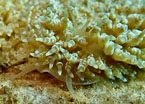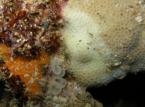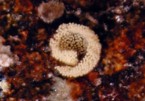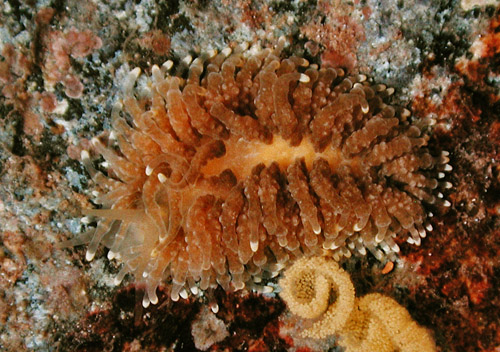_______________
Additional Photos

front

mottled

on black

young

feeding damage

egg mass

|
Tenellia lugubris (Bergh, 1870)

Maximum size: about 55 mm.
Identification:
The
body
of this aeolid is translucent white but may sometimes appear
yellow when the gonad is visible through the body wall. The long, lumpy
cerata have varying amounts of white pigment along
their length and, often, a prominent white swelling on the distal half.
The color of the cerata is determined by the food source and
ranges from cream to brown with cream tips. The rhinophores are smooth
and translucent brown.
Natural history:
Tenellia lugubris
is a moderately common species that has been found in tide pools and in
rock and coral
habitats from < 1 to 6 m (< 3 to 20 ft). It occurs at protected
to moderately exposed sites. It feeds on the coral
genus Porites and may be
found on the
surface of the colonies at night or
underneath them by day. It has also been found on the undersides of
rocks near Porites colonies. It is a
prolific egg-layer, depositing over one egg mass per day when mature,
often in clusters. The egg masses are white or cream and "flare" at the
distal edges. This
is one of the few nudibranchs for which life history data
has been collected. Studies by Larry Harris (1975) showed a
generation time of 38 days from egg to egg, and a lifespan of
approximately 4.5 months. Gochfield and Aeby (1997)
reported Thalassoma
duperrey, Thalassoma ballieui,
Chaetodon auriga, Pilodius aerolatus, Phymodius monticulosus, Thalamita sp., and Gonodactylus falcatus as predators
of this species.
Distribution:
Big Island, Maui, Oahu, French Frigate Shoals and Midway: widely
distributed
in the
Indo-Pacific; also in the eastern Pacific.
Taxonomic notes: It
is listed as Phestilla
sibogae Bergh, 1905 in Kay, 1979, Gosliner, 1980, and Bertsch & Johnson, 1981. Aeolidiella
edmondsoni Ostergard, 1955 is a synonym (Kay, 1979). It was
probably first recorded in Hawaii from Waikiki, Oahu by C. H. Edmondson
in April, 1922. It's listed in Ostergard, 1950 as Aeolidia
sp. It's referred to as an
unidentified aeolid on page 184 of Edmondson, 1946. The name means
"mournful." It is listed in many sources as Phestilla lugubris.
Photo: PF:
found by CP; Napili Bay, Maui; May 22, 1997.
Observations and comments:
Note
1: ( )
|
|







